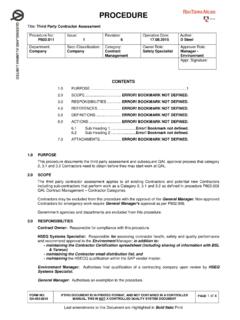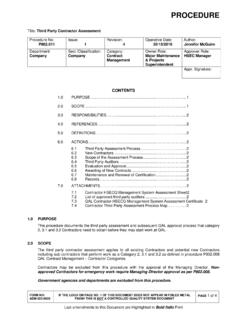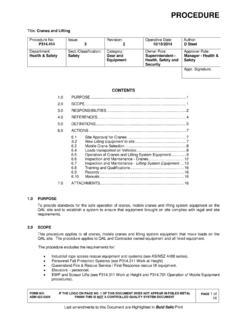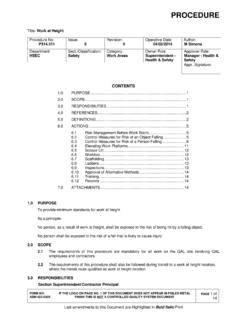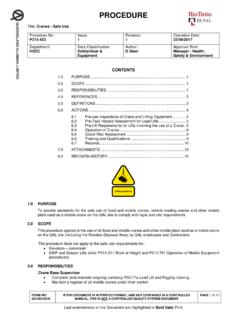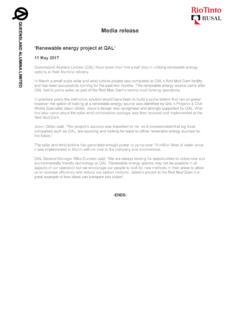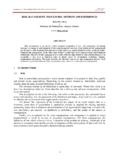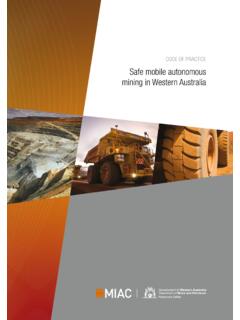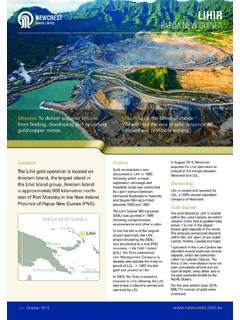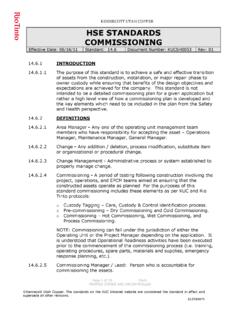Transcription of CONTENTS
1 FORM NO: ADM-023-0305 IF THE LOGO ON PAGE NO. 1 OF THIS DOCUMENT DOES NOT APPEAR IN FOILED METAL FINISH THIS IS NOT A CONTROLLED QUALITY system DOCUMENT PAGE 1 of 16 Last amendments to this Document are Highlighted in Bold Italic Print PROCEDURE Title: Operation of Mobile Equipment Procedure No: Issue: 4 Revision: 6 Operative Date: 17/12 /2013 Author: Rebecca Devine Department: HSEC : Safety Category: Vehicles/Mobile Equipment Owner Role: HR Manager Approver Role: H&S Manager Appr. Signature: CONTENTS PURPOSE .. 2 2 RESPONSIBILITIES .. 2 REFERENCES .. 3 DEFINITIONS .. 4 ACTIONS .. 6 Licencing and Competencies .. 6 Traffic Regulations .. 6 Access to Site .. 6 Mobile Phones .. 7 Seat Belts .. 7 Passengers in Mobile Equipment and Mobile Powered Plant 7 Smoking in Mobile Equipment .. 7 Emergency 7 Speed Limits & Signage .. 7 Rights of Way .. 7 Mobile Equipment Risk Assessment .. 7 Mobile Equipment Operation .. 8 Personal Protective 9 Starting Up and Moving Off Warning Signals.
2 10 10 Loading Mobile Equipment and Securing Loads .. 10 Positive Communications .. 11 Overtaking .. 11 Distance between Mobile Equipment .. 11 Approaching Heavy Machinery Equipment in Stockpile Areas, Landfill and Ash and Red Mud Disposal 11 U Turns .. 12 Alighting from Mobile Equipment .. 12 Access and egress to Mobile Equipment other than the cabin13 Equipment Breakdown .. 13 Oversize Mobile Equipment .. 13 Tyre and Rim 13 Tyre Fires .. 13 Contacting Overhead Powerlines or Struck by Lightning .. 14 Traffic Control .. 14 Vehicle and Heavy Machinery Equipment Recovery .. 14 Trailer/Towed Equipment .. 15 Loading and Unloading MEWP from Vehicles .. 15 Transportation of Gas Cylinders .. 15 Transportation of Dangerous Goods .. 15 Traffic Management Plan .. 15 Title: Operation of Mobile Equipment No: Issue: 4 Rev: 6 Approval: (Inits) FORM NO: ADM-023-0305 IF THE LOGO ON PAGE NO. 1 OF THIS DOCUMENT DOES NOT APPEAR IN FOILED METAL FINISH THIS IS NOT A CONTROLLED QUALITY system DOCUMENT PAGE 2 of 16 Audit.
3 15 Records .. 16 ATTACHMENTS .. 16 Traffic Management Plan Minimum Standard .. 16 PURPOSE The purpose of this procedure is to define the driving requirements for mobile equipment at QAL. This document should be read in conjunction with the detailed manufacturer s operating instructions for different mobile equipment and the Mobile Equipment Standard procedure SCOPE The scope of this procedure covers operation of all mobile equipment on the QAL site including company vehicles, contractor vehicles and private vehicles. Mobile cranes are covered by Procedure Forklifts are covered by Procedure RESPONSIBILITIES Legal and Other Requirements QAL is committed to manage mobile equipment and driving in accordance with legal and other requirements. A comprehensive list of legal and other requirements for mobile equipment and driving is located in the Legal Obligations Manual located on Portal under Qnet/HSEC. Reference to frequently used Australian Standards and legislative requirements are listed on Portal.
4 Roles and Responsibilities Role Responsibility Superintendents / Contractors Implement the requirements of this procedure within their area for all mobile equipment activities. Ensure that suitably trained persons are licenced and competent to operate mobile equipment. Safety Standing Team C3 Vehicles and Driving One role of the Safety Standing Team C3 Vehicles and Driving is to review and recommend changes to: Operation of Mobile Equipment and Tyre Management Plan Project related Traffic Management Plans Mobile Equipment Standards This team does not co-ordinate the execution of normal road or mobile equipment maintenance, nor create Project Statements for future improvements to these assets. Superintendent Health, Safety & Security Approve an exemption from wearing a seatbelt on medical grounds. Approve an exemption to driving on site without a QAL driving competency assessment CTO (Eg. Tour Bus Driver) Title: Operation of Mobile Equipment No: Issue: 4 Rev: 6 Approval: (Inits) FORM NO: ADM-023-0305 IF THE LOGO ON PAGE NO.
5 1 OF THIS DOCUMENT DOES NOT APPEAR IN FOILED METAL FINISH THIS IS NOT A CONTROLLED QUALITY system DOCUMENT PAGE 3 of 16 Role Responsibility Mobile Equipment Owner Audit the system . Mobile equipment is operated and maintained to the standard defined in this procedure and in line with appropriate asset standards. Mobile equipment is made available for scheduled maintenance and repair. Mobile equipment used for work purposes undergo a risk assessment and the risk assessment is reviewed annually. Ensure drivers who are required to use vehicles off site hold a current vehicle drivers licence for that class of vehicle. Ensure persons operating mobile equipment are licenced and authorised under the mobile equipment driving competency CTO and that records of competency are maintained. Supervisors Ensure risk assessments are re-validated at any time the scope of work changes or the risk of mobile equipment operations changes. Ensure completion of mobile equipment Pre-Start Check Sheets.
6 Ensure that parking, and lay down areas are maintained in a safe, clean and tidy condition, and that designated safe parking areas are established and incorporate fundamentally stable parking. Ensure their team members operating mobile equipment are licenced and competent. Maintenance Planners/ Schedulers /Maintainers Ensure requirements of this procedure and manufacturers guidelines/instructions are followed during the planning of routine servicing, modification and maintenance of mobile equipment. Mobile equipment Operators Maintain their driving licence as required by legislation. Maintain their mobile equipment driving competency CTO within the renewal period as specified in this procedure. Complete inspections and ensure pre-start checklists are filled in correctly. Use all site mobile equipment in a safe manner and operate within the rated load capacity. Adhere to all site speed limits and road restrictions. Ensure the driver and all passengers wear their seatbelts at all times.
7 Report all near hits, incidents and mobile equipment damage to their Supervisor immediately and ensure the incident scene is preserved. Park the mobile equipment in a fundamentally stable position and use a designated safe park area whenever possible. First Response Co-ordinator Ensure emergency response persons are trained and competent to operate site emergency services vehicles. REFERENCES Control of Entry To and Exit From the Site Employee Code of Conduct Competent to Operate Specified Equipment Title: Operation of Mobile Equipment No: Issue: 4 Rev: 6 Approval: (Inits) FORM NO: ADM-023-0305 IF THE LOGO ON PAGE NO. 1 OF THIS DOCUMENT DOES NOT APPEAR IN FOILED METAL FINISH THIS IS NOT A CONTROLLED QUALITY system DOCUMENT PAGE 4 of 16 Isolation, Tag and Lockout Procedure Road Closure and Part Road Closure Oxy Fuel Gas Systems Safe Use and Maintenance Cranes and Lifting Operation of Forklifts Mobile Equipment Standards Protective Equipment Plant Minimum Requirements Accidents Involving Company Vehicles, Hire, or Lease Vehicles Tyre Management Plan QM50-140-02 Trailers and Towing Accessories Engineering Standard SM76 Mobile Equipment Training Module Workplace Health and Safety Act 1995 Part 3 Workplace Health and Safety Regulation 2011 Rio Tinto Performance Standard C3 Vehicles and Driving Rio Tinto C3 Light Vehicle Driving Guideline, 2005 Rio Tinto C3 Vehicle and Driving Guidance Note, 2005 Rio Tinto C3 Tyre and Rim Guidance Notes, 2009 Code of Practice Plant Transport Operations (Road Use Management) Act 1995 Schedule 4 Dictionary.
8 Transport Operations (Road Use Management Vehicle Registration) Regulation 1995 Transport Operations (Road Use Management Road Rules) Regulation 2009 Transport Operations (Road Use Management Vehicle Standards and Safety) Regulation 2010 Transport Operations (Road Use Management Mass, Dimensions and Loading) Regulation 2005 Vehicle Standards Bulletin (VSB1) Building Small Trailers Australian Design Rules Australian Code for the Transport of Dangerous Goods by Road & Rail (ADG 07). AS 1698 Protective Helmets for Vehicle Users AS 1742 Manual of Uniform Traffic Control Devices AS 1801 Occupational Protective Helmets DEFINITIONS Term Definition Mobile Equipment Any mechanically or electrically driven machine capable of moving under its own power and requires a driver/operator. Mobile equipment is under the control of an operator and includes a trailer attached to the equipment, and heavy machinery equipment. Examples include but are not limited to: Regardless of engine capacity, all hoists, mobile truck mounted concrete placing booms, load shifting equipment, dozers, excavators, forklifts, front-end loaders, backhoes, graders, order picking forklift trucks, boats, road rollers, skid steer loaders, and scrapers.
9 Tractors, road sweepers etc. Remotely controlled mobile equipment. It includes any form of transport that moves on wheels and a hovercraft; but not a train or tram. (Transport Operations (Road Use Management) Act 1995 Schedule 4 Dictionary). Gross Vehicle Mass (GVM) The maximum design load of a vehicle including the weight of the driver, passengers, load being carried and the vehicle body. Title: Operation of Mobile Equipment No: Issue: 4 Rev: 6 Approval: (Inits) FORM NO: ADM-023-0305 IF THE LOGO ON PAGE NO. 1 OF THIS DOCUMENT DOES NOT APPEAR IN FOILED METAL FINISH THIS IS NOT A CONTROLLED QUALITY system DOCUMENT PAGE 5 of 16 Term Definition Light Vehicles (LV) Light vehicles are any vehicle weighing less than tonnes gross vehicle mass (GVM), as per Queensland road rules. For the purpose of these rules, light vehicles are vehicles, personnel carriers and miscellaneous vehicles comprising: Cars, 4WD sports utility vehicles, pickups, utilities, mini loaders (Dingo).
10 Personnel carriers such as long wheel base troop carriers light trucks with crew cabins and other vehicles designated from time to time as personnel carriers. Any three wheeled self-propelled equipment and any associated sidecar including quad bikes, skidoos and similar vehicles. Any vehicle that requires the driver to hold a Queensland car drivers licence. Medium Vehicles Medium vehicles are any vehicle over tonnes GVM, but excluding the heavy machinery equipment. Examples of medium vehicles include: Buses carrying 12 or more persons large forklifts and telehandlers; small front end loaders and back hoes; service trucks; and tippers including gravel trucks, bulk materials delivery trucks and road trains (heavy). Heavy Machinery Equipment Heavy Machinery Equipment includes mobile equipment such as: bulldozers, graders, loaders, rubber tyred backhoes, scrapers, compactors, agricultural tractors, rubber tyred dozers; rear dump trucks carrying overburden, refuse, rehabilitation material; water trucks, road sweepers and all excavators.
